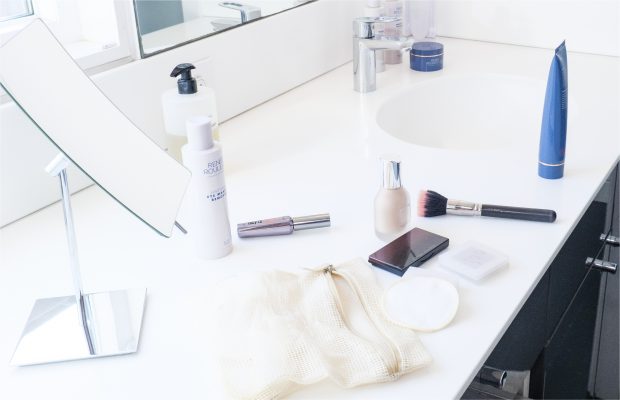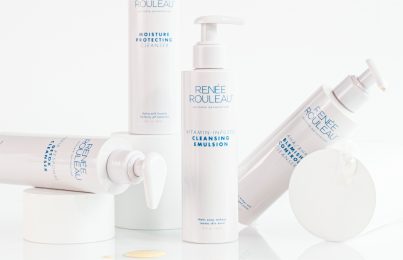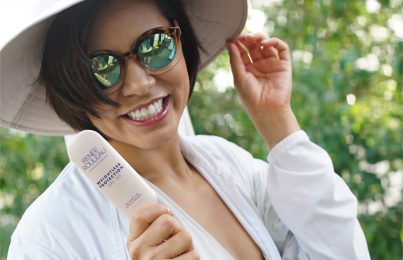After a long day of work (or maybe a late night out on the town), most of us are looking forward to nothing more than going home to sit back and relax. But, one daunting task may be holding us back: removing our makeup. I try to be a realist, and the truth is that sleeping in your makeup every once in a blue moon isn’t the end of the world, especially so long as you’re still cleansing every 12 hours or so. But make no mistake, making it a habit can wreak havoc on your skin.
- Mistake #1: Not Using a Designated Eye Makeup Remover
- Mistake #2: Not Using the Right Technique to Remove Eye Makeup
- Mistake #3: Not Double Cleansing
- Mistake #4: Using An Old-School Cleansing Balm To Remove Makeup
- Mistake #5: Not Using A Washcloth To Help Remove Makeup
- Mistake #6: Using Cleansing Wipes
- Mistake #7: Wetting Your Skin Before Removing Makeup
- Mistake #8: Skipping Toner After You Double Cleanse
- Mistake #9: Neglecting Hard-to-Reach Areas
While not the most exciting part of anyone’s beauty routine, removing your makeup at the end of the night is a crucial step in any skincare routine. When you improperly remove your makeup or neglect doing so at all, you put your skin at risk of irritation, breakouts, and premature aging. It also means the rest of your skincare products aren’t going to be as effective since they don’t have a clean canvas to work with.
After over 30 years as an esthetician, I’ve seen people make all kinds of mistakes when it comes to removing their makeup (and even made a few of those mistakes myself back in the day!). Here are the top 9 makeup removal mistakes you might not know you’re making—and how to correct them.
Mistake #1: Not Using a Designated Eye Makeup Remover
A common question I get is whether or not people can use their face cleanser to remove eye makeup. As a general rule, I don’t suggest this. The eyes and eye area are extremely sensitive, so ingredients that are fine for the rest of your face may not be suitable here. In addition, many cleansers contain oils; the eye area can be very prone to milia, which oils can trigger. This is why I always suggest using a designated eye makeup remover as the first step of makeup removal.
I personally use (and recommend) something gentle and oil-free, like the Soothing Eye Makeup Remover. I formulated this product to have a pH similar to that of our natural tears so that it wouldn’t cause irritation.
Mistake #2: Not Using the Right Technique to Remove Eye Makeup
In addition to using a designated eye makeup remover, it’s important you use it the right way! Our eyes are the first place to show signs of aging (think fine lines). This is because the thin skin surrounding them gets wear and tear through every smile, squint, and eye rub. It’s so important that we treat our eyes delicately. Excessive rubbing and tugging on your eyes is not only unnecessary, but it can also lead to irritation and premature wrinkles.
The solution? Make sure you’re using your eye makeup remover correctly. Saturate a pad, then hold it over your eye for 20 seconds (more for waterproof makeup). Then, very gently wipe your eye, and the makeup should lift right off without harsh rubbing.
Watch this video to master the proper technique for eye makeup removal.
Mistake #3: Not Double Cleansing
If you’re wearing stubborn foundation makeup or something heavy-duty like waterproof sunscreen, double cleansing is important for proper makeup removal. The first cleanse serves to remove makeup, sunscreen, and other products so that the second cleanse can actually reach your skin to clear away dirt, oil, and pollutants. This is the most effective way to cleanse your skin thoroughly. Double cleansing not only prevents clogged pores, breakouts, and other skin problems, but it also prepares your skin to absorb any toners and serums you plan on applying afterward.
Be sure to read my step-by-step guide to double cleansing.
Mistake #4: Using An Old-School Cleansing Balm To Remove Makeup
Speaking of double cleansing, many people love a cleansing balm as the first step to dissolve makeup. While balms are, in fact, great at breaking down difficult-to-remove formulas like long-wear foundation or waterproof sunscreen, they can leave an oily film behind on the skin. This film can prevent the serums you apply after from properly penetrating, and eventually, it can lead to skin issues like dehydration or clogged pores.
If you frequently use heavier makeup or just prefer balm-like cleansers, there are still options out there for you. Better Than Balm, my most recent product and newest nightly staple, is an oil-based cleanser that I spent three years perfecting. Its unique, dual-phase technology allows it to transform from an oil into a milky gel. This allows it to break down makeup and then rinse away clean. Not only does it leave skin feeling soft and clean without a nasty residue, but it’s also a safe option for all 9 skin types.
Learn more about why old-school balms can cause issues and how Better Than Balm is different.
Btw, if you don’t like the texture oil or balm cleansers, you can also use micellar water as your first cleanse for makeup removal.
Mistake #5: Not Using A Washcloth To Help Remove Makeup
One of the top mistakes people make when double cleansing is not using a gentle cloth to wipe their skin. At first glance, this may not seem like such an important step, but here’s why it is.
Whether you use a cleansing lotion, balm, or, oil, these are responsible for breaking down makeup so it can easily be removed. But, wiping with a washcloth ensures a thorough cleanse by using a lifting action to actually remove those makeup particles. Otherwise, you’re basically just loosening them and then rubbing them around (much like a cleansing wipe, more on that shortly). A gentle wiping action makes all the difference for thorough makeup removal.
It’s important to always treat your skin gently, which is why I recommend a baby washcloth or this soft alternative to harsh cloths.
Mistake #6: Using Cleansing Wipes
I understand cleansing wipes are convenient, and granted, sometimes this is the best we can do (think camping or music festivals). However, cutting corners and using cleansing wipes outside of these rare occasions is one of the biggest mistakes someone can make when it comes to makeup removal.
Cleansing wipes can lead to rubbing and tugging on the skin, which can increase signs of premature aging. Also, many cleansing wipes contain harsh, drying, or irritating ingredients. Coupled with all that rubbing, it puts those with sensitive skin at a higher risk for irritation and breakouts. Even if you gently use these wipes to remove makeup, they don’t even provide an effective cleanse. Cleansing wipes serve essentially the same function as putting cleanser on your face and then not washing it off—you’re rubbing dirt and makeup around more than actually removing it. To truly clean your skin, you need to use a cleanser with water and, ideally, a soft cloth to lift everything off.
Wipes aren’t the only cleansing method that can damage your skin. Learn why I never recommend washing your face with bar soap.
Mistake #7: Wetting Your Skin Before Removing Makeup
The reason so many of us reach for oil-based cleansers when removing stubborn makeup is that like dissolves like, meaning oil is best dissolved with more oil. Whether you reach for a cream, lotion, or balm cleanser, make sure you’re applying it to dry skin. This will allow the oil in the cleanser to latch onto the oil on your face without being intercepted by water. Once you’ve massaged your cleanser onto dry skin for a good 30 seconds (at least), you can wet your fingers and introduce oil to the process.
Remember that if you’re using a gel cleanser (which I recommend for morning cleansing), they don’t contain oil and require water to be activated. This means they’re best applied to wet skin.
Mistake #8: Skipping Toner After You Double Cleanse
Once your makeup is removed and your skin is clean, use a toning cloth to apply an alcohol-free toner. If there is any residue, makeup, or dirt left on the skin, this will remove it. Using a toner post-cleanse can also help remove impurities that may be lingering in your tap water.
Some people see toner as an extraneous skincare step, and while you can certainly get away with not using one, I love toner for these five great skin benefits it provides.
Mistake #9: Neglecting Hard-to-Reach Areas
We’ve made it this far, so there’s no sense in cutting corners now! By skipping hard-to-reach areas during cleansing, such as around the nose, neck, jaw, and scalp, we leave makeup residue behind that can lead to clogged pores and breakouts. This is especially true from the perimeter of the face near the hairline. Not only is this an area where lots of sweat an oil can accumulate, but if you use hair products, you want to totally remove anything that’s migrated onto your skin. When clients complain of breakouts or clogged pores along their hairline, this is one of the first things I ask them about.
Next up, learn how removing your makeup earlier in the evening instead of right before bed can benefit your skin’s circadian rhythm.
Celebrity Esthetician & Skincare Expert
As an esthetician trained in cosmetic chemistry, Renée Rouleau has spent 30 years researching skin, educating her audience, and building an award-winning line of products. Her hands-on experience as an esthetician and trusted skin care expert has created a real-world solution — products that are formulated for nine different types of skin so your face will get exactly what it needs to look and feel its best. Trusted by celebrities, editors, bloggers, and skincare obsessives around the globe, her vast real-world knowledge and constant research are why Marie Claire calls her “the most passionate skin practitioner we know.”



